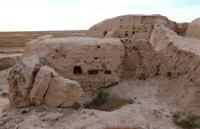You are here
Cuba ancient settlement.


Sacred places of the Fergana valley.
“For a moment, a moment - and life flashes...
Let the fun flash for a moment!
Beware, for life is the essence of creation,
When you spend it, so will it pass”
Omar Khayyam.
Tours on architectural monuments of the Fergana valley.
In the north-western outskirts of the district center of Kuva in the Fergana region for several years, excavations of the ancient settlement of Cuba were carried out. In the early Middle Ages, Cuba was a fairly large trade and craft settlement, there were developed crafts, especially pottery, jewelry, metalworking.
The settlement appeared, as evidenced by archaeological finds, in the IV - III centuries BC. Cuba’s life as an important political and economic center of the Fergana Valley lasted until the 13th century and was interrupted by the invasion of Genghis Khan.
Scientists here uncovered the ruins of eighty houses of handicraft workshops with five streets and a city square. Under the cultural layer dating back to the Xth – XIth centuries, the remains of a Buddhist temple emerged. It was built on the ledge of a natural hill, to the top of which a stone staircase led, and towered over the surrounding countryside, was visible from far approaches.
It was separated from the residential quarters of the settlement for the pahs wall on a stepped base. The remains of the Buddhist complex were hidden under the layers of subsequent times, including three tiers of burials of the Xth – XIth centuries.
During the construction of the temple, pahsa and mud brick were used, and the floors were wooden. Its powerful walls were preserved only to a height of no more than two meters, but this allowed the researchers to reconstruct the layout of the Buddhist complex.
On the south side, the entrance led to a sanctuary with an altar raised to a meter platform. Around the altar, on the walls of the sanctuary were elevated Sufa. Here sacrifices to deities took place in the form of flowers, fruits and aromatic incense.
From the east, a rectangular temple building adjoining the temple was oriented from south to north. The archaeologists cleared a mud brick sufa from one of the walls, on which they apparently sold cups for sacrifices, smoking candles and fragrant herbs, since there were found whole and broken ceramic bowls and simple molded vessels.
In the southern part of the temple in a deep niche there was an aivan under a wooden shed. On the wall of the aivan, remains of a mural were found, which served as a background for sculptures. Here were the fragments of two horse statues and the soldiers accompanying them.
Near the entrance, blocking it, lay the magnificent clay figure of the Buddha, about two and a half human tall. Nearby were found fragments of statues of other Buddhist characters, including the defenders of Buddhism, the goddess Sri Devi.
Scientists suggest that the sculptural composition in the aivan of the temple depicted the struggle of the forces of good led by Sri Devi with the leaders of the demons and the army of Mara, the enemy of the Buddha.
To determine what kind of hypostasis this or that sculpture belongs to, the archeologists were helped by painting the statues. The gods of good are painted blue, cream and white and are represented in yellow, red and blue robes.
Their heads are crowned with princely diadems, there are bracelets on their wrists, they are decorated with necklaces of flowers, bands with bells and rosettes. The gods are defenders of the faith, painted in blue and black, depicted with great expression.
They have a fierce look to frighten evil demons. Their wreaths and necklaces are woven with skulls, bracelets in the form of snakes, capes and loincloths of tiger skins, and hair flying like tongues of flame. To determine the exact date of construction of the Buddhist complex in Kuva has not yet succeeded.
It is clear that the time of its heyday fell on the second half of the VII century, and in the XIII century the temple was destroyed by the Arabs. In any case, the ruins of the sanctuary and the temple bear clear traces of the fire that destroyed the building.
The excavations of ancient Kubi confirmed that at the beginning of our era Buddhism was spread on the territory of Uzbekistan not only in Surkhandarya, where the bulk of Buddhist monuments are concentrated, but also penetrated far to the north, into the Fergana Valley.
Authority:
https://meros.uz
Photos
Alexander Petrov.







